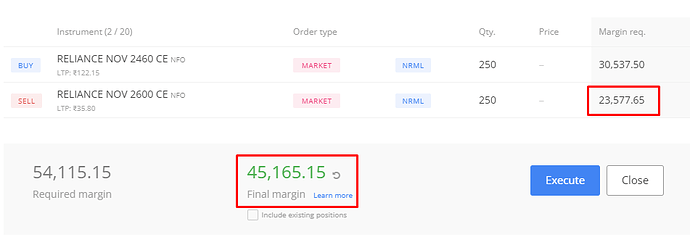Please consider positional trades of multiple days for all queries
-
For Futures and Short Options, 50-50 cash-collateral margin is applicable only on the upfront margin at the time of taking the position, or for subsequent increase in margin too (through an increase in SPAN+Exposure)
-
For increased delivery margin requirements during the final week of physically settled FNO expiry,
What type of funds are needed to meet the just delivery margin requirement? (so that positions don’t get squared off automatically.
- Collateral margin (from any type of security)
- Or cash equivalent margin (like pledged LiquidBees margin)
- Or 50:50 combination of collateral and cash or cash equivalents
- Or Actual Cash
For taking delivery, I understand actual cash funds are required. The above question is just asking what kind of margin required to maintain open positions so that I can square of myself any time of the expiry day.
-
I understand that if do not square off and go for physical delivery, I need to bring in actual cash. And it can be brought in after-market hours of expiry day and also from trades squared off on the expiry day will be counted for it, as stated here: Bulletin - Physical delivery margin: In-the-money long options - #7 by ShubhS9
Failing to bring in the cash will result in debit balance and interest penalty of 0.05%.
So, just want a confirmation if this policy still applies today. -
Pledged Liquidbees are considered cash collateral, but still cannot be used for taking delivery?
If not, can I sell unpledged Liquidbees on the Expiry date, and the money that will actually come on T+2 day, be considered for the delivery (as per the link in question 3, trades squared off on Expiry day are fine), or will it still be considered as a debit balance for those 2 days with interest penalty (consider additional funds not added).
If selling on Expiry date still results in debit balance and penalty, what date is ideal to sell on (E-1 or E-2 or E-3)? -
For Short Options, the delivery margins in final week or on expiry day will be applicable regardless of the moneyness of the option?
While it needs to be ITM for Long Options. -
(consider 40% of contract value > SPAN+Expsoure Margins for this question and next one
and Long option is ITM)
Hedged Position
Example: Long Reliance 1500 Calls + Short Reliance 1520 Puts
On expiry day, Max delivery margin applicable
= 50% of contract value for long + 40% of contract value for short
= 50% * (1500 * lot size) + 40% * (1520 * lot size)
= Approx. 90% of contract value (consider 1520 contract for conservative measure)
Synthetic Long using options
Example: Short Reliance 1500 Puts + Long Reliance 1500 Calls
Here also Total delivery Margins are max 90% of contract value (1500 * lot size)
So maintaining this 90% won’t result in automatic square off? And if reliance closes at 1510 and going for delivery of long call, then need 100% contract value for it (in cash) otherwise it will go for debit balance and interest penalty.
- There are margin benefits for normal trading before the delivery week. But is there any delivery margin benefit for these scenarios during the final week and expiry day?
Strategy 1) Ratio Spreads
Long 1 lot of Reliance 1500 Calls
Short 2 lots of Reliance 1520 Calls
Max Risk → 2 lots (if client closes the long call prematurely)
Strategy 2) Synthetic Covered Call – Synthetic Long using Options and Covered Call
Short 1 lot of Reliance 1500 Puts
Long 1 lot of Reliance 1500 Calls
Short 1 lot of Reliance 1520 Calls
Max Risk → 1 lot (even if client closes any 1 leg prematurely)
(assuming yes to Question 5)
Total Maximum Delivery Margin Required without delivery margin benefit for both strategies
= 50% on long and 2*40% on short
= approx. 130% of contract value
Ratio Spread → 130% of contract value without delivery margin benefit
Vs
80% of contract value for 2 short calls
Even if Ratio spread will have lower risk than 2 naked shorts. (80% margin covers the 50% of long call too)
Strategy 2 has lower risk of 1 lot but will be charged 130% delivery margin, so in my opinion, should receive some delivery margin benefit to bring it to max 100% or lower of contract value
